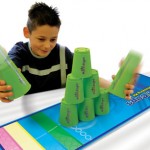Equipment and Setup:
- For Grades K-2 Use playground balls
- For Grades 3/4/5 Use basketballs
- Students spread out in their personal space
- Adjust this list to the level of your students
- Teacher up front to lead activities
Teacher Leads – Students Follow
- Foot Dribble: Bounce ball up to self using foot
- Hold ankle dribble: Dribble ball while holding one ankle and balancing on one foot.
- Heel Slap Dribble: Dribble with one hand while slapping your heel with the other
- Massage and Dribble: Can you rub the back of your neck and dribble a ball?
- Bounce High: Bounce ball high while ball doesn’t go above hand
- Bounce Low: Bounce as low as possible
- Catch while you’re off the floor: Throw ball and catch while jumping
- Catch as low as you can: Bounce ball and catch as close to the floor as possible
- Butterfly Drill: Hold ball between legs – do scissors – ball stays between legs
- Throw back to front: Hold ball in back with both hands and throw in front to catch
- Throw front to back: Throw ball up and catch it behind your back
- Throw, jump 360, catch: Throw ball up and make a complete turn and catch
- Roller ball: Balance ball behind your neck, let the ball roll down your back, then catch ball at your lower back.
- Floor slap: Throw ball on the floor – slap both hands on floor – then catch
- Stand to Lying Down Dribble: High dribble, medium dribble, sit on the floor and keep dribbling, then lie down on your back and keep dribbling. Keep dribbling and slowly begin standing up.
- Homer Simpson: Run in a circle while dribbling your ball in the same place.
- Monkey Walk: Walk while moving the ball between your legs
- Crossover Dribble: Dribble right -left- right -left.
- Heads Up Dribble: Watch the teacher move a ball side-to-side and move accordinglyHold ball in back with both hands and throw in front to catch
- Homer Simpson: Run in a circle while dribbling your ball on an exact spot on the floor. Then reverse directions. Can you do it while skipping? Skipping backwards?
Basketball/Playground Balls Game and Activity Links


